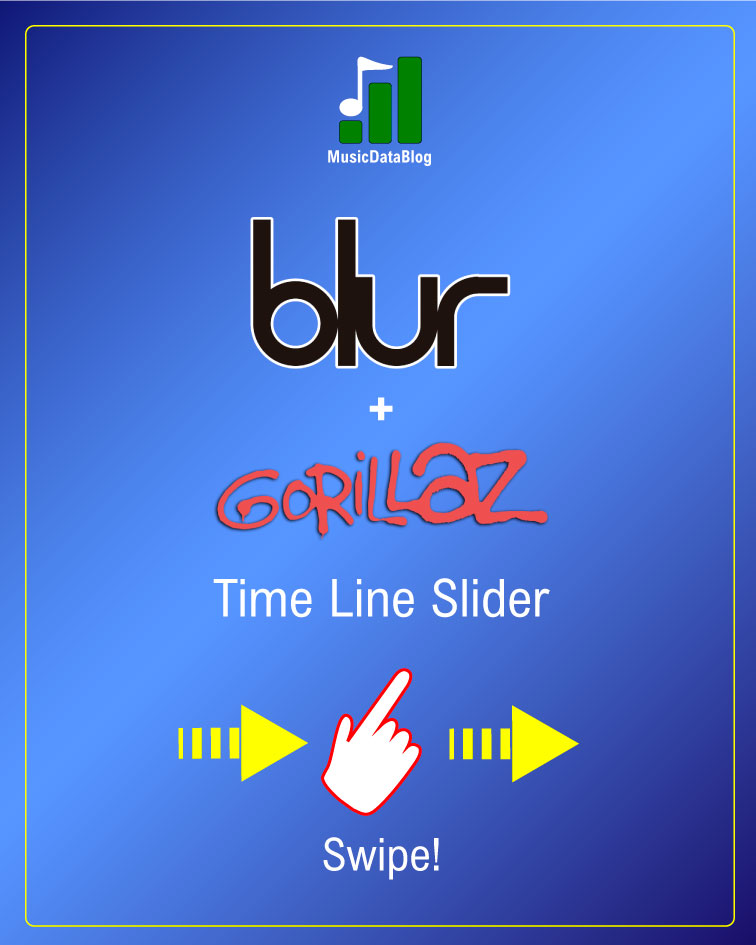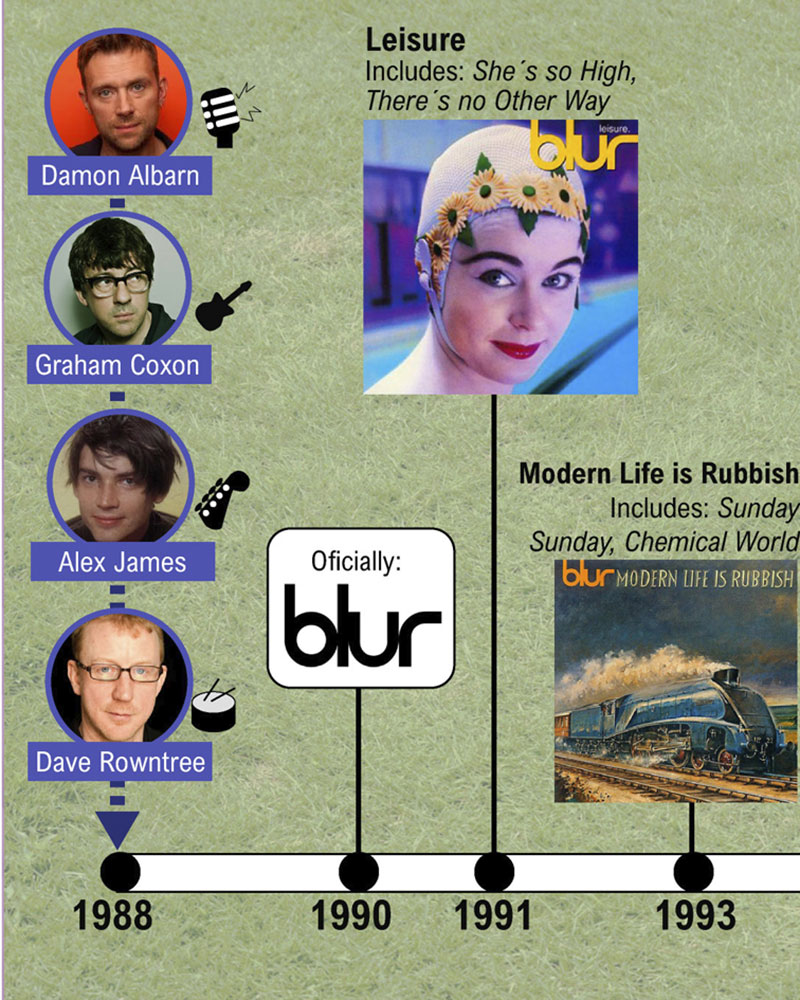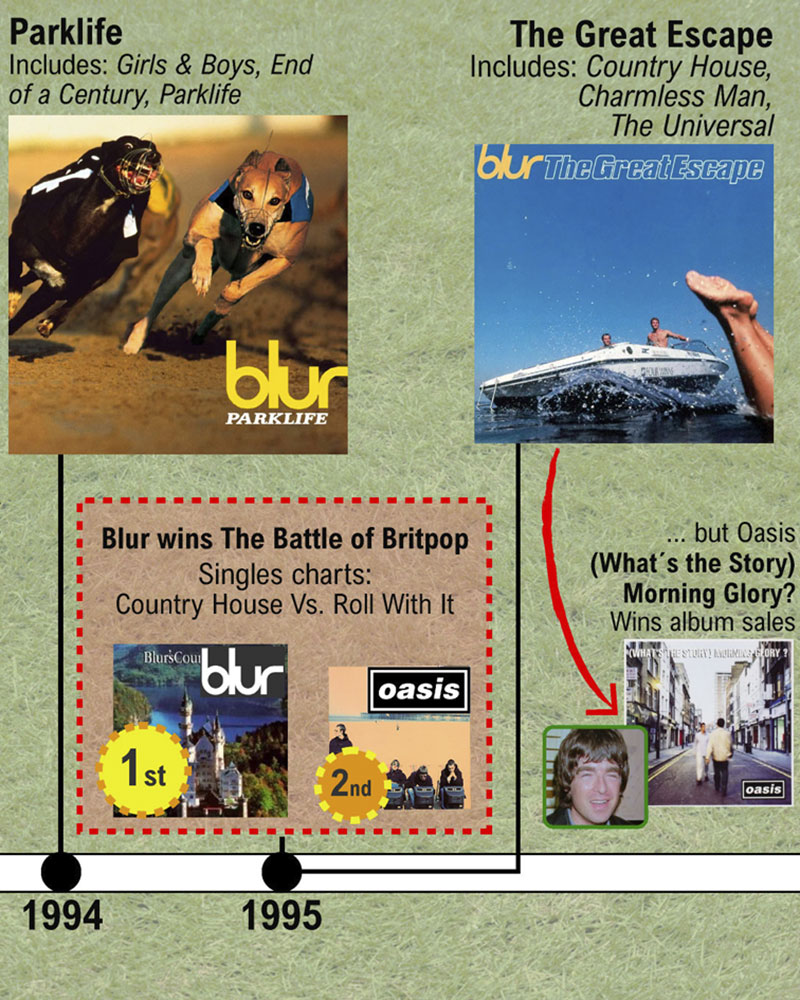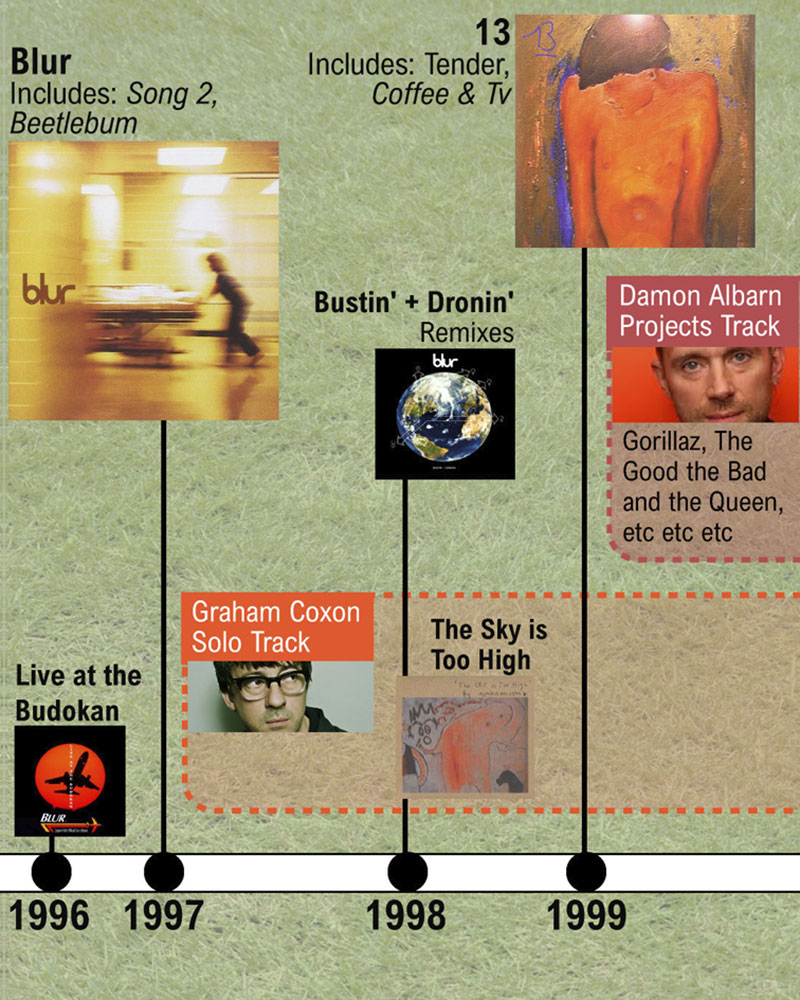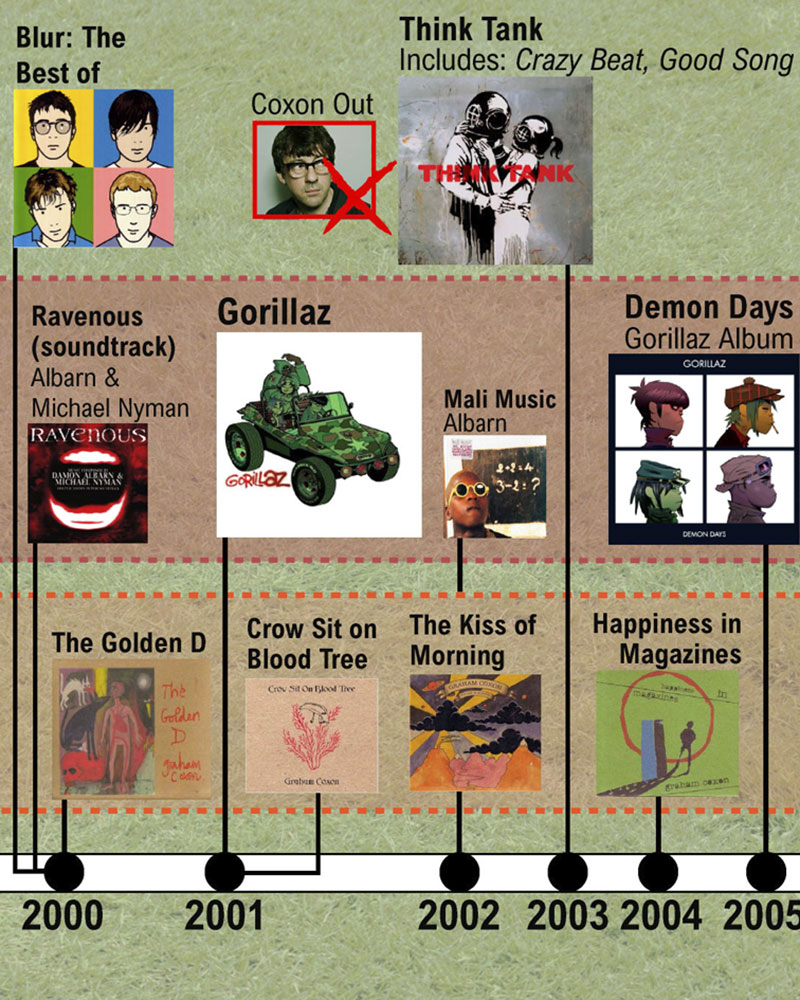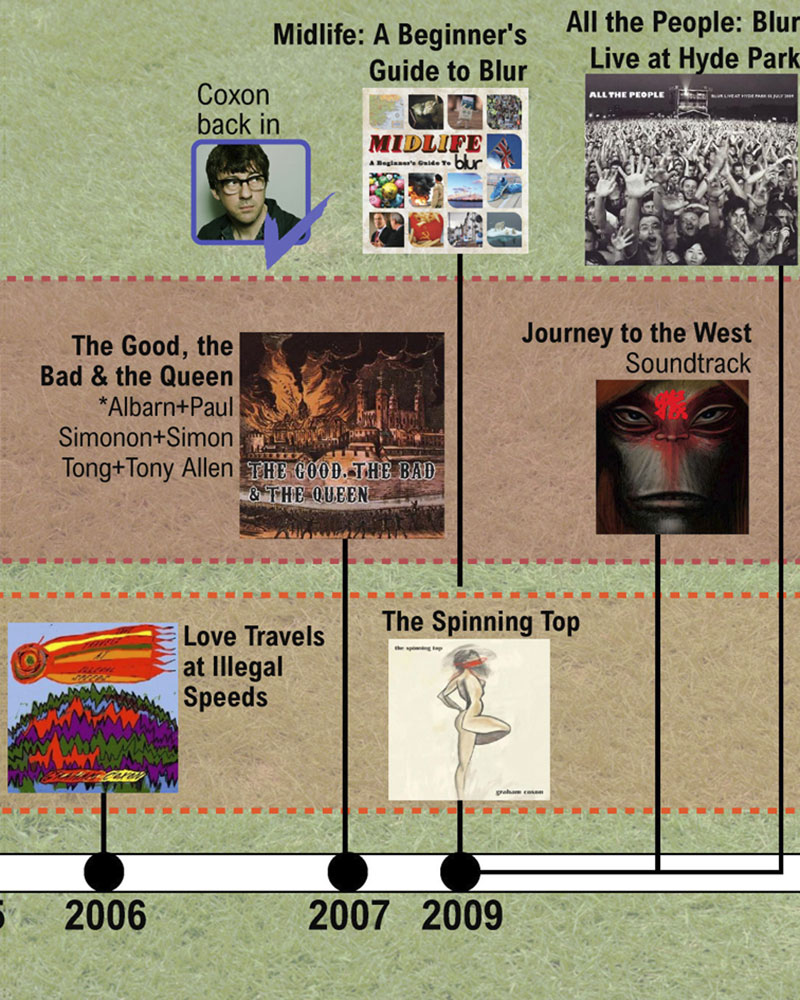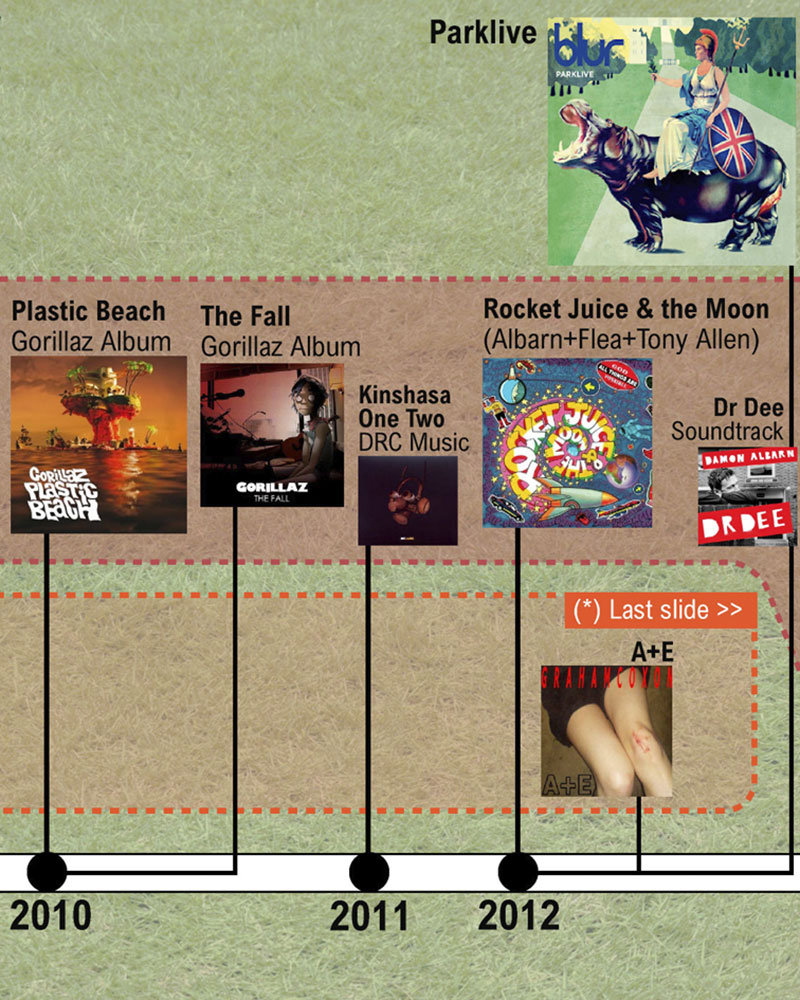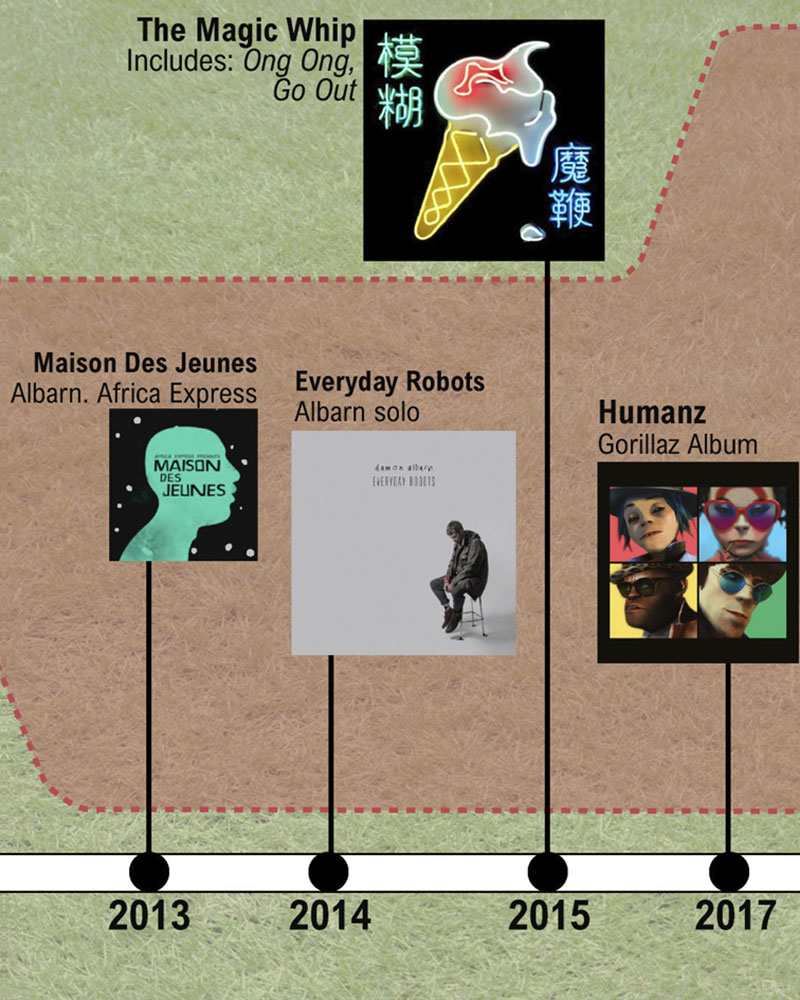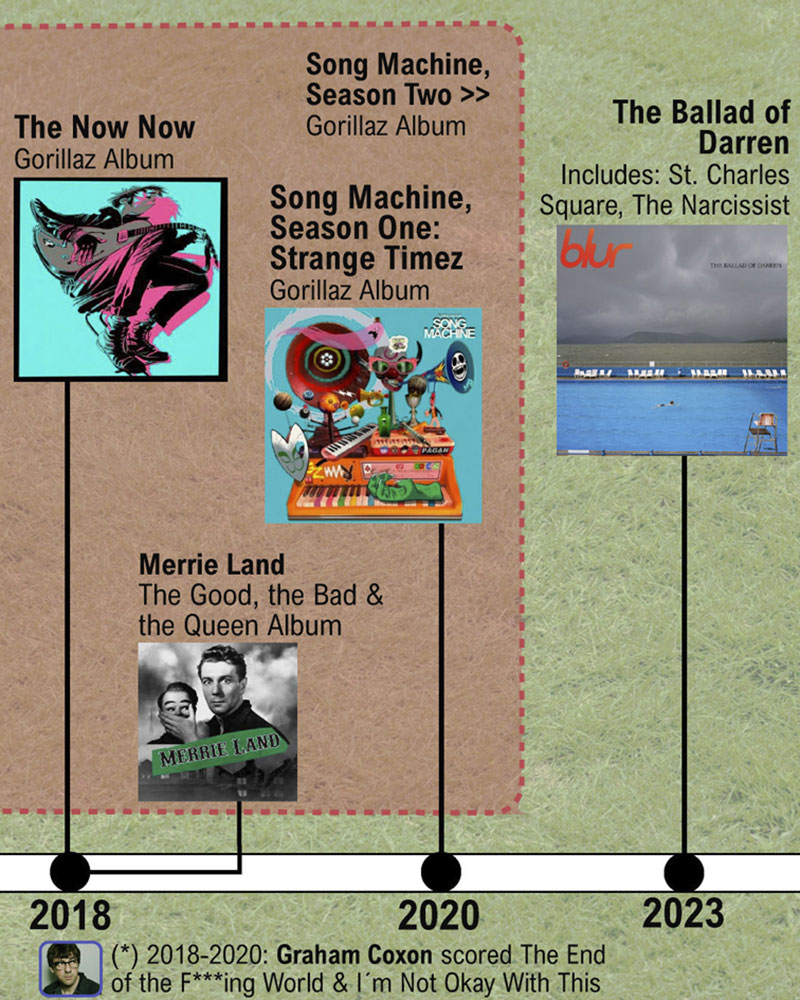Is the British band Blur already history? It appears so, but time will tell. Meanwhile, swipe through this timeline infographic as we go through their whole career and other related projects, such as Gorillaz and solo endeavors by Damon Albarn and Graham Coxon.
Blur stands as one of the most emblematic bands of Britpop, the musical movement that dominated UK charts in the ’90s. Their story is marked by talent, rivalry, and the evolution of its four constant members, particularly lead singer Damon Albarn, who also spearheaded the successful project Gorillaz.
In this article, we unravel how Blur was formed, their most important albums and songs, and how their journey intertwines with Gorillaz.
Blur’s most recent album, The Ballad of Darren, was released in 2023. According to reports, Damon Albarn has hinted that Blur may have come to an end. Is it so?
Brief history of Blur
1988 to 1993: Blur’s Beginnings
Blur’s story kicked off in 1988 when four friends from the London School of Art decided to form a band called Seymour. Damon Albarn (vocals and keyboard), Graham Coxon (guitar), Alex James (bass), and Dave Rowntree (drums) quickly caught the attention of the Food Records label. This record company offered them a contract in exchange for a name change. Thus, Blur was born.
Their debut album, Leisure, was released in 1991 and achieved commercial success with songs like “There’s No Other Way” and “She’s So High,” encapsulating the prevalent shoegaze sound of the time.
Unsatisfied with their initial direction, Blur sought a unique identity by drawing inspiration from British pop music of the ’60s and ’70s, particularly bands like The Kinks, The Beatles, and The Who. This inspiration culminated in “Modern Life Is Rubbish,” their second album released in 1993, marking the inception of Britpop—a genre reclaiming British culture against the dominance of American grunge.
1994 to 1995: Blur’s Success
The pinnacle of Britpop was reached with Blur’s third album, “Parklife,” in 1994. This socially and culturally impactful record portrayed the everyday life of the British middle class with humor and irony. Tracks like “Girls & Boys,” “End of a Century,” and “Parklife” became generational anthems, propelling Blur to stardom.
Rivalry with Oasis
Blur became the leading figure in Britpop alongside Oasis, with whom they engaged in a famous media rivalry materializing in the head-to-head singles “Country House” and “Roll With It” in August 1995. Blur won that battle, but Oasis outsold them with their album “(What’s the Story) Morning Glory?”
The truth is that Oasis’ album sounded completely different. On their side, Blur’s fourth album, “The Great Escape” (1995), was a darker and more melancholic work than “Parklife,” reflecting societal disillusionment and alienation. While commercially successful, it received mixed reviews due to internal band issues and creative differences between Albarn and Coxon, exacerbated by substance abuse.
If you want to read the other side of the story, we went through the Oasis vs. Blur “chart battle” on our Oasis history timeline.
1997 to 2002: Experimental Phase
In 1997, Blur underwent a radical sonic transformation with their fifth self-titled album. Influenced by American indie rock from bands like Pavement and Sonic Youth, they departed from Britpop, delving into lo-fi, noise rock, and hip-hop. The album achieved success both in the UK and the US, with the single “Song 2” becoming a hit, eventually leading to the inception of Albarn’s parallel project, Gorillaz—a virtual band blending alternative rock with hip-hop, trip-hop, and electronic music.
Their sixth album, “13” (1999), was more experimental and personal, reflecting the emotional breakups of Albarn and Coxon. Produced by William Orbit, known for his work with Madonna and Beck, the album received critical acclaim but didn’t match the commercial success of its predecessors.
Blur’s hiatus
In 2002, Blur released their seventh album, “Think Tank,” marking Coxon’s departure during recording due to differences with Albarn. Influenced by electronic music, dub, and psychedelic rock, the album featured collaborations with artists like Fatboy Slim and Norman Cook, demonstrating Blur’s ability to reinvent themselves. While well-received, it was the last album before Blur’s hiatus.
Following the release of “Think Tank,” Blur entered a period of inactivity, with members pursuing other musical projects. Albarn focused on Gorillaz, a virtual band comprised of animated characters—2-D (vocalist), Murdoc Niccals (bassist), Russel Hobbs (drummer), and Noodle (guitarist).
The history of Gorillaz
Gorillaz began in 2001 as an alternative project by Damon Albarn, featuring illustrator and comic artist Jamie Hewlett and, more recently, producer and percussionist Remi Kabaka Jr. Gorillaz often collaborates with session musicians to complement vocals, drums, bass, and other instruments.
The music style of Gorillaz has elements of rap, hip-hop, pop, and electronica. If you want to learn more about the band’s sound, we have included them as part of the bands influenced by Massive Attack.
Gorillaz swiftly became one of the most successful and unique bands of the 21st century, with albums like “Demon Days” (2005), “Plastic Beach” (2010), and “Humanz” (2017).
Albarn continues to lead Gorillaz until this very day, with releases like “The Now Now” (2018) and “Song Machine” (2020), along with other projects like The Good, the Bad & the Queen, and Africa Express.
So far, Gorillaz has released eight albums, including their 2023 LP Cracker Island.
Also, it is worth mentioning that Damon Albarn released a solo album under his name, Everyday Robots, in 2014.
Coxon’s solo career
As for Graham Coxon, he resumed his solo career, releasing albums like “Happiness in Magazines” (2004), “Love Travels at Illegal Speeds” (2006), and “A+E” (2012). James ventured into music production and writing, while Rowntree delved into politics and activism.
Coxon collaborated with artists such as Paul Weller and Pete Doherty, in addition to composing soundtracks for TV series like “The End of the F***ing World” and “I Am Not Okay with This.”
Graham Coxon has released eight studio albums, between 1998 and 2012. His debut solo album is The Sky Is Too High and the last LP he recorded is titled A+E.
2009 to Present: Blur’s Return
In 2009, Blur reunited for a series of concerts in the UK, culminating in a massive performance at the Glastonbury Festival. The band showcased that they remained one of the most influential and beloved figures in British rock, with their legacy intact. In 2012, Blur released two new songs, “Under the Westway” and “The Puritan,” part of a compilation titled “21.” That same year, the band received the Brit Award for Outstanding Contribution to Music.
In 2015, Blur surprised fans with their eighth album, “The Magic Whip,” recorded in Hong Kong during a canceled tour. This marked Coxon’s return and a revival of their earlier, more guitar-oriented sound. Tracks like “Lonesome Street,” “Go Out,” and “Ong Ong” showcased a mature and cohesive band still passionate about creating good music. The album received critical acclaim and was another Mercury Prize nominee.
In 2023 Blur released what may be their final record: The Ballad of Darren. After finishing the album’s tour, singer Damon Albarn said that the future of the band is uncertain. The band has not released any official statement.

